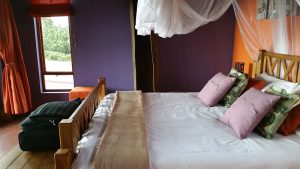What is the largest waterfall in Uganda?
The stunning landscapes of Uganda’s National Parks, combined with spectacular scenery, offer some of Africa’s most memorable visitor experiences. Bwindi Impenetrable National Park provides the best opportunity in the world for viewing rare primates during mountain gorilla tracking, making it the highlight of any tour in Uganda and answers your question about What is the largest waterfall in Uganda.
Encounters with chimpanzees in the tranquil forests surrounding Murchison Falls, Queen Elizabeth, and Kibale National Parks are among the reasons why visitor numbers to Uganda’s protected areas are once again rising. Kidepo’s breathtaking scenery, with its large buffalo herds and unique, beautiful, virgin hills, offers a wonderful experience, while the Rwenzori, with their chain canopy of string glaciers, present a mystical challenge with majestic scenery.
Murchison Falls National Park, situated at the northern end of the Albertine Rift Valley, where the sweeping Bunyoro escarpment meets vast, palm-dotted savannah, is Uganda’s largest and oldest conservation area. Hosting 76 species of mammals and 451 birds, it was first gazetted as a game reserve in 1926.
The park is divided by the Victoria Nile, which plunges 54m over the remnant rift valley wall to create the dramatic Murchison Falls, the centerpiece of the park and the final event in an 80km stretch of rapids. The mighty cascade drains the last of the river’s energy, transforming it into a broad, placid stream that flows quietly across the rift valley floor into Lake Albert.
At Murchison Falls, the Nile squeezes through an 8m wide gorge and plunges with a thunderous roar into the Devil’s Cauldron, creating the trademark rainbow. This stretch of river provides one of Uganda’s most remarkable wildlife spectacles. Regular visitors to the riverbanks include elephants, giraffes, and buffaloes, while hippos, Nile crocodiles, and aquatic birds are permanent residents.
Accessibility: Roads
Several routes lead to the Nile at Paraa, the heart of the Murchison Falls Conservation Area. A vehicle ferry, running roughly hourly throughout the day, crosses the river here.
Southern entrance gates
Two southerly routes out of Masindi town, a 4-hour drive (305km) from the capital Kampala, lead to Paraa. En route to Masindi lies the Ziwa Rhino Sanctuary, home to Uganda’s wild rhinos. Tracking them on foot supports the important initiative to reintroduce rhinos to protected areas.
A longer but more scenic alternative runs 135km from Masindi to the park’s Bugungu gate, passing through Budongo Forest and descending the rift valley escarpment with views across Lake Albert towards the mountains of the Congo.
Northern entrance gates
Murchison Falls National Park can also be accessed via Chobe, Wankwar, Mubako, and Tangi gates north of the Nile. These gates are reached from the Kampala-Pakwach Road, which crosses the Nile at Karuma Falls Bridge in the northeastern corner of the park, 260km from Kampala. They are convenient for visitors traveling to/from Gulu Town and Kidepo Valley National Park.
Air travel
Pakuba airfield, 19km from North Paraa, is accessible via chartered aircraft from Entebbe International Airport or Kajjansi airfield near the capital, Kampala. Other airfields in the park include Chobe to the East and Bugungu near Murchison Falls to the south.
Activities: Birding
Both game drives and launch trips offer opportunities to encounter distinct birdlife, including Savannah Forest birds, water birds, and Albertine Rift endemics. The park’s main birding attraction is the shoebill, best seen in the dry season.
Game drives
Exploring the Buligi game tracks on the northern bank with a trained ranger guide offers fantastic opportunities to see and photograph a wide range of animals in the Nile Valley. Your guide will have a good idea of where the lions are hiding, and you may even spot a leopard at dusk!
Hiking and natural walks
The vast landscapes and varied scenery of Murchison Falls National Park and the surrounding Conservation Area can be explored on foot. Trails through Kaniyo Pabidi and Rabongo Forest provide sightings of many primates and birds, while guided swamp walks of 2-4 hours around the Nile Delta offer possible shoebill sightings.
Launch trips
A launch trip upstream from Paraa presents an astonishing display of wildlife and culminates with a memorable frontal view of the falls. Recommended for birders is a morning cruise downstream to the Nile-Lake Albert Delta. Alternatively, a tranquil sundowner cruise offers the classic view of an equatorial sunset reflected on the river.
Sport Fishing
The banks of the Nile below Murchison Falls provide an exciting challenge to anglers. The Nile perch, living in the strong current and highly oxygenated waters, offers the chance to land a massive catch—the record is 108kg! get to know What is the largest waterfall in Uganda?
Cultural encounters
Energetic dancers from Mubako perform around lodge campfires, creating a magical African experience at dusk. The Boomu Women’s Group offers accommodation, a craft shop, and village tours, revealing the realities of life in rural communities.
Let us be your best guide and trusted partner for the tour and answer your question about What is the largest waterfall in Uganda?




